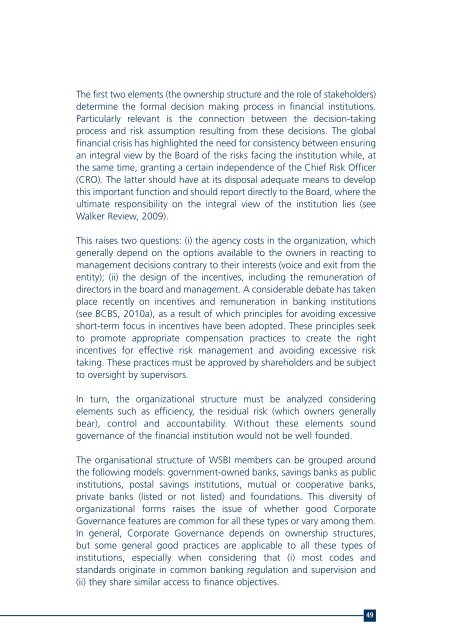Corporate Governance and Access to Finance - ESBG
Corporate Governance and Access to Finance - ESBG
Corporate Governance and Access to Finance - ESBG
You also want an ePaper? Increase the reach of your titles
YUMPU automatically turns print PDFs into web optimized ePapers that Google loves.
The first two elements (the ownership structure <strong>and</strong> the role of stakeholders)determine the formal decision making process in financial institutions.Particularly relevant is the connection between the decision-takingprocess <strong>and</strong> risk assumption resulting from these decisions. The globalfinancial crisis has highlighted the need for consistency between ensuringan integral view by the Board of the risks facing the institution while, atthe same time, granting a certain independence of the Chief Risk Officer(CRO). The latter should have at its disposal adequate means <strong>to</strong> developthis important function <strong>and</strong> should report directly <strong>to</strong> the Board, where theultimate responsibility on the integral view of the institution lies (seeWalker Review, 2009).This raises two questions: (i) the agency costs in the organization, whichgenerally depend on the options available <strong>to</strong> the owners in reacting <strong>to</strong>management decisions contrary <strong>to</strong> their interests (voice <strong>and</strong> exit from theentity); (ii) the design of the incentives, including the remuneration ofdirec<strong>to</strong>rs in the board <strong>and</strong> management. A considerable debate has takenplace recently on incentives <strong>and</strong> remuneration in banking institutions(see BCBS, 2010a), as a result of which principles for avoiding excessiveshort-term focus in incentives have been adopted. These principles seek<strong>to</strong> promote appropriate compensation practices <strong>to</strong> create the rightincentives for effective risk management <strong>and</strong> avoiding excessive risktaking. These practices must be approved by shareholders <strong>and</strong> be subject<strong>to</strong> oversight by supervisors.In turn, the organizational structure must be analyzed consideringelements such as efficiency, the residual risk (which owners generallybear), control <strong>and</strong> accountability. Without these elements soundgovernance of the financial institution would not be well founded.The organisational structure of WSBI members can be grouped aroundthe following models: government-owned banks, savings banks as publicinstitutions, postal savings institutions, mutual or cooperative banks,private banks (listed or not listed) <strong>and</strong> foundations. This diversity oforganizational forms raises the issue of whether good <strong>Corporate</strong><strong>Governance</strong> features are common for all these types or vary among them.In general, <strong>Corporate</strong> <strong>Governance</strong> depends on ownership structures,but some general good practices are applicable <strong>to</strong> all these types ofinstitutions, especially when considering that (i) most codes <strong>and</strong>st<strong>and</strong>ards originate in common banking regulation <strong>and</strong> supervision <strong>and</strong>(ii) they share similar access <strong>to</strong> finance objectives.49
















